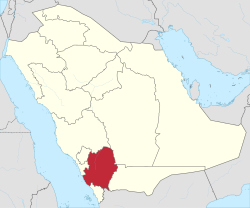Tabalah (Arabic: تبالة, romanized: Tabāla) is a village and wadi in the Asir Province of Saudi Arabia.[2] It is situated about 240 kilometers (150 mi) south of Ta'if,[3] 200 kilometers (120 mi) east of the Red Sea coastline and 100 kilometers (62 mi) west of Bisha.[2] In the 2010 census, Tabalah had a population of 5,670, of which 4,990 were citizens of Saudi Arabia and 680 non-citizens.[1]
Tabalah
تبالة | |
|---|---|
| Coordinates: 19°59′52″N 42°13′47″E / 19.99778°N 42.22972°E | |
| Country | |
| Province | 'Asir |
| Population (2010)[1] | |
| • Total | 5,670 |
History
editDuring the pre-Islamic period (pre-7th century), Tabalah was home to the shrine of the idol of Dhu'l-Khalasa.[2] In the early Islamic period (7th–13th centuries), it was a large and prosperous town on the pilgrimage route to Mecca from Yemen, in between the way-stations of Bisha and Ajrab.[2] According to al-Baladhuri and al-Tabari, the inhabitants of Tabalah accepted Islam without resistance and the Islamic prophet Muhammad imposed a poll tax on the Christians and Jews of the town and nearby Jurash.[4] Muhammad had led or dispatched expeditions against members of the Khath'am tribe in Tabalah in 629 and 630 CE.[2] The medieval Arabic geographers note that the town contained several springs and wells which watered the town's date palm groves and agricultural fields.[2] According to the 10th-century geographer al-Hamdani, most of its inhabitants hailed from the Quraysh tribe of Mecca.[2] It is most known in the medieval sources as being the short-lived governorship of al-Hajjaj ibn Yusuf,[5] who considered it an insignificant post because it was hidden by a hill.[2]
References
edit- ^ a b "The General Population and Housing Census, 2010:Number of inhabitants in cities with a population greater than (5000) people" (excel). General Authority of Statistics, Kingdom of Saudi Arabia. 2010. Retrieved 30 January 2020.
- ^ a b c d e f g h Smith 2000, p. 10.
- ^ Oseni 1982, p. 129.
- ^ Hitti 1916, p. 91.
- ^ Larsson 2003, p. 188.
Bibliography
edit- Hitti, Philip Khuri (1916). The Origins of the Islamic State, Being a Translation from the Arabic, Accompanied with Annotations, Geographic and Historic Notes of the Kitâb Fitûh Al-buldân of Al-Imâm Abu-l Abbâs Ahmad Ibn-Jâbir Al-Balâdhuri, Volume 1. New York and London: Columbia University & Longman, Green & Co.
- Larsson, Göran (2003). Ibn García's Shuʻūbiyya Letter: Ethnic and Theological Tensions in Medieval Al-Andalus. Leiden: E. J. Brill. ISBN 90-04-12740-2.
- Oseni, Zakariyau I. (1982). "Early Life of al-Hajjaj b. Yusuf". Studies in Islam. 19. New Delhi: Indian Institute of Islamic Studies: 125–136.
- Smith, G. R. (2000). "Tabāla". In Bearman, P. J.; Bianquis, Th.; Bosworth, C. E.; van Donzel, E. & Heinrichs, W. P. (eds.). The Encyclopaedia of Islam, Second Edition. Volume X: T–U. Leiden: E. J. Brill. p. 10. ISBN 978-90-04-11211-7.
